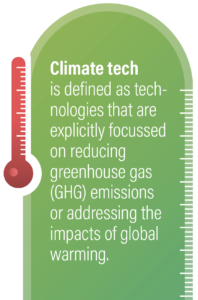
In climate tech investing
In the wake of COP27—the most recent annual United Nations summit on climate—people are reflecting on a year in which climate action has fallen short of ambition. PwC’s latest Net Zero Economy Index analysis—an indicator of the progress members of the Group of 20 (G20) countries have made in reducing energy-related carbon emissions and decarbonising their economies—found that the global rate of decarbonisation declined to just 0.5 per cent annually over the past 12 months,[1] far below the 15.2 per cent rate that society now needs to limit warming to 1.5° Celsius above pre-industrial levels, as set out in the 2015 Paris Agreement. With a shrinking window for action, it is more crucial than ever to accelerate innovation. But, as this article by Emma Cox, Will Jackson-Moore, Leo Johnson and Tarik Moussa from PwC asks, has recent financing for technology to combat climate change—commonly referred to as ‘climate tech’—met the urgency of the challenge?
The answer is mixed. On the one hand, there are reasons to remain optimistic:
- In the face of their first real test over the past decade, climate tech markets have shown encouraging resilience. Against a background of war in Europe, inflation and a sharp correction in the capital markets, there was potential for investor confidence to crumble, as it had in the notorious boom-and-bust era of cleantech a decade ago. Critically, it did not: in fact, eight in 10 investors surveyed in 2023 plan to increase their investment in environmental, social and governance (ESG) products over the next two years. And the investors interviewed remain optimistic about the outlook for the market.
- Comparing climate tech to the wider market backs up this story. Climate tech’s share of investment in 2022 hovered at historic highs, even taking into account a natural softening after a strong 2021 and a retreat in special purpose acquisition companies (SPAC) activity.
On the other hand, there are also reasons for concern:
- Compared with a bumper investment year in 2021, 2022 saw a steady drop in overall investment levels.
- The volume of critical early-stage funding required to scale up the next wave of climate tech success stories is trending in the wrong direction. The deficit in funding and the decline in the number of deals for early-stage start-ups that are looking to scale up—first identified in 2022—appear to be deepening.
- Investment is still not aligned with carbon impact, reflecting an inefficient market for investing in climate outcomes.
What is climate tech?
Climate tech is defined as technologies that are explicitly focussed on reducing greenhouse gas (GHG) emissions or addressing the impacts of global warming. Climate tech applications can be grouped into three broad, sector-agnostic groups, those that: directly mitigate or remove emissions; help us adapt to the impacts of climate change; or enhance our understanding of the climate.
The term ‘climate tech’ is purposely broad to reflect the wide range of technologies and innovations being used to address GHG emissions and the array of industries in which they are being applied. The data underpinning the analysis set out in this article includes venture capital and private equity investment into start-ups.
A cyclical slowdown in climate tech investing?

The contraction of venture capital investments in climate tech may reflect the kind of cyclicality seen elsewhere in corporate deal-making—a natural decline after a period of significant growth. Much of the surge in climate tech investment in 2021 can be attributed to a handful of megadeals facilitated through SPACs. Although many investors at the time were positive about the impact of SPACs in improving liquidity, they were sceptical about whether SPACs would remain a major contributor to investment in the medium term. Interestingly, this maintenance of investment levels has been in defiance of economic headwinds and a recent slowdown in the overall venture capital market.
Demand gets turbocharged

On the public-sector side, policymakers appear increasingly to appreciate the connections among climate security, energy security and economic security. Indeed, many public-sector climate initiatives are communicated in terms of economic growth first and foremost, rather than being primarily driven by ESG considerations. This approach enables policymakers to shore up public support because of volatile economic conditions, and not just in spite of them.
There have been recent moves in China that could benefit climate tech start-ups. For example, China has invested heavily in its net-zero transition, spending United States dollars (USD) 266 billion (approximately Chinese yuan (CNY) 1.6 trillion) on the deployment of low-carbon technologies in 2021.[2] As this spending deepens the country’s supply chain for minerals that are critical to the net-zero transition, start-ups that focus on solutions such as battery technology and electric vehicles gain a competitive advantage.
While venture investment in climate tech may have slowed, wider investment into the net-zero transition—including technology—signals increasing demand. These macro trends are coming both from the public sector, where policy support is creating an enabling environment for climate tech start-ups, and from the private sector, which continues to ratchet up demand for net-zero solutions.
Meanwhile, the private sector has turned its focus to the ‘time value of carbon’ – how to balance near-term net-zero levers while also developing solutions to mitigate emissions in the long term. For the latter, initiatives such as the First Movers Coalition and Frontier have emerged to strengthen the demand signal for climate tech solutions, which is allowing investors to fund the scaling up of emerging start-ups. Investors expect these initiatives to drive increased investment and growth in climate tech.
An inefficient market for investing in climate outcomes
Public- and private-sector initiatives might each be bringing in more investment dollars, but to meet the increasingly urgent net-zero climate goals, additional finances need to be focussed on two areas: early-stage funding and technologies with the highest potential for reducing emissions.
The first challenge is around the number and total value of small deals, typically at the earliest stages of funding, which have been declining since the start of 2021. The trend is troubling, because, although levels of dry powder remain high, it is unclear how investment might be deployed effectively without a stronger pipeline of early-stage funding for climate tech start-ups. As one fund manager mused in an interview, it may soon become apparent that there are not enough high-quality start-ups coming through from early rounds of funding for later stage funds to deploy all the money raised. This gap between initial, pre-seed funding and series A and B levels is termed the ‘valley of death’ for early-stage start-ups. Why this gap exists requires further investigation.
The second challenge is around impact, which can be looked at from two angles: a sector view and a technology view. At the sector level, the flow of investment into climate technology is still not in proportion to each sector’s contribution to the flow of GHGs into the atmosphere. However, there are signs of modest improvement.
A comparison of technological maturity with emissions-reduction potential—or forward-looking climate impact—reinforces an image of a market that is not yet efficient at meeting climate objectives. Solutions such as food waste technology and carbon capture and removal remain comparatively underfunded, for a multitude of reasons. To keep Paris Agreement goals within reach, an enabling environment would support more funding towards technologies that have the highest potential to lower emissions and that are sufficiently advanced to have an immediate impact on emissions.
Conclusion
As society grapples with how to halve emissions by 2030, more discussion is needed on the solutions and structural transformation required for a fair and just transition. Greater investment in climate tech is needed, and not just at the top level, but with a better spread across sectors and solutions, as well as different start-up sizes and technological maturity levels, and especially in areas that can have the greatest impact over the shortest period. This year’s contraction in investment is certainly reason for concern, particularly due to the impact it will have in the longer term—but there are signs that investors, policymakers and other stakeholders remain eager to pick up the pace.
PricewaterhouseCoopers (PwC) is a leading global professional service provider
with the purpose of building trust in society and solving important
problems. With offices in 152 countries and almost 328,000 people, PwC is among
the leading professional services networks in the world. PwC helps
organisations and individuals create the value they are looking for, by
delivering quality in Assurance, Tax and Advisory services. PwC has made a
worldwide commitment to achieve net zero greenhouse gas (GHG) emissions with a 2030
goal. The PwC network will work with its clients to support their efforts,
contribute to public policy developments in support of net zero and decarbonise
our operations and supply chain through Science Based Targets initiative (SBTi)-validated
near-term targets.
[1] Net Zero Economy Index 2022, PwC, 2022, viewed 18th September 2023, <https://www.pwc.co.uk/services/sustainability-climate-change/insights/net-zero-economy-index.html>
[2] China Is the Growth Engine of World’s Low-Carbon Spending, BloombergNEF, 18th February 2022, viewed 18th September 2023, <https://about.bnef.com/blog/china-is-the-growth-engine-of-worlds-low-carbon-spending/>


Recent Comments